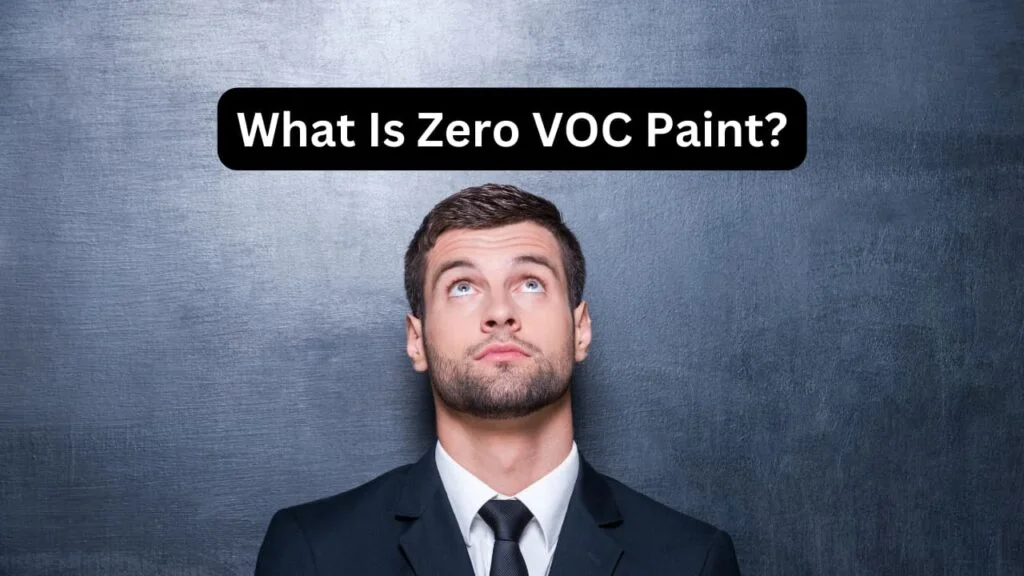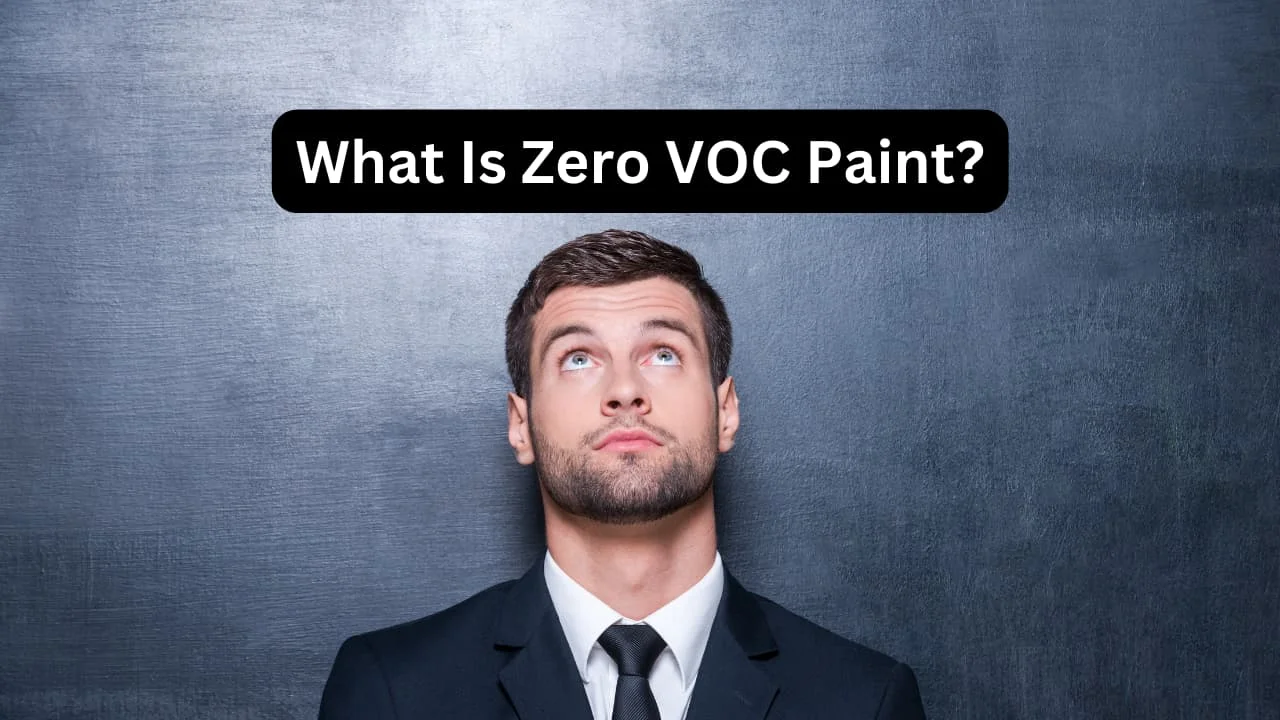Have you ever wondered what exactly zero VOC paint is? Well, if you’re like us, you’ve probably seen it mentioned at the hardware store or heard people talking about it, but you might not know exactly what it means. Don’t worry, we’ve got the scoop and we’re here to fill you in!
Zero VOC paint stands for zero volatile organic compound paint. Now, you might be thinking, what on earth are volatile organic compounds? Well, they’re chemicals that can be found in many household products, including traditional paint. These compounds are released into the air as the paint dries and can contribute to indoor air pollution.
Just What Is Zero VOC Paint?
Luckily, zero VOC paint is an alternative that contains minimal or no volatile organic compounds. This means that when you paint your walls with zero VOC paint, you won’t be releasing harmful chemicals into your home’s environment. Sounds pretty great, right? In our upcoming article, we’ll dive deeper into the benefits of using zero VOC paint and provide some tips for choosing the right one for your next painting project. Stay tuned!
Zero VOC paint refers to paint that contains very low or no Volatile Organic Compounds (VOCs). VOCs are chemicals that easily vaporize at room temperature and can have harmful effects on both the environment and human health. Traditional paint often contains high levels of VOCs, which can release toxic gases into the air during and after application. Zero VOC paint, on the other hand, is formulated with minimal or no VOCs, making it a safer and more environmentally friendly option.


Table of Contents
Benefits of Zero VOC Paint
Improving Indoor Air Quality
One of the primary advantages of zero VOC paint is its positive impact on indoor air quality. When conventional paint is applied, it can release a variety of VOCs into the air, such as formaldehyde, benzene, and toluene. These chemicals can contribute to indoor air pollution and may have detrimental effects on human health. Zero VOC paint significantly reduces or eliminates the release of harmful gases, helping to create a healthier indoor environment.
By using zero VOC paint, you can reduce your exposure to these harmful chemicals, which can cause respiratory problems, allergic reactions, and even more serious health issues. This is especially important for those with asthma or other respiratory conditions, as well as for young children and the elderly who may be more susceptible to the negative effects of VOCs.
Reducing Health Risks
In addition to improving indoor air quality, zero VOC paint also helps reduce health risks associated with traditional paint. VOCs have been linked to various health problems, including headaches, dizziness, nausea, and eye, nose, and throat irritation. Prolonged or repeated exposure to VOCs may even increase the risk of more severe conditions, such as liver and kidney damage, as well as certain types of cancer.
Zero VOC paint eliminates the need to worry about these health risks, making it a safer option for both professionals and homeowners who want to minimize the impact of painting on their well-being.
Eco-Friendly and Sustainable
Aside from the health benefits, zero VOC paint is also an environmentally friendly and sustainable choice. VOCs can contribute to the formation of ground-level ozone, a major component of smog, and they can also contribute to air pollution and global warming. By using zero VOC paint, you are reducing your carbon footprint and helping to protect the environment.
Furthermore, some zero VOC paints are manufactured using recycled materials, further reducing the overall environmental impact. These paints are often made from natural resources or renewable plant-based ingredients, making them a greener alternative to traditional paint.
Types of Zero VOC Paint
Zero VOC paint comes in various types, each with its own unique characteristics and benefits. Here are a few common types:
Water-Based Zero VOC Paint
Water-based zero VOC paint, also known as latex paint, is the most commonly used type of zero VOC paint. It is easy to apply, dries quickly, and has minimal odor. Water-based paint is also easy to clean up with just soap and water, making it a convenient choice for both professionals and DIY enthusiasts.
Natural Plant-Based Zero VOC Paint
Natural plant-based zero VOC paint is made from ingredients derived from plants, such as oils from seeds, nuts, or other botanical sources. These paints are often free from harmful chemicals and can achieve a high level of indoor air quality. Plant-based paints can also have a distinct smell, reminiscent of the natural ingredients they are made from.
Mineral-Based Zero VOC Paint
Mineral-based zero VOC paint is made from minerals and other natural compounds. These paints are non-toxic and provide excellent coverage and durability. They are also resistant to mold and mildew, making them a suitable choice for high-moisture environments like bathrooms and kitchens.
Application and Coverage
When applying zero VOC paint, there are a few important considerations to ensure the best results.
Preparing the Surface
Just like with any other paint, proper surface preparation is crucial for achieving a smooth and long-lasting finish. Make sure to clean the surface thoroughly, remove any peeling or flaking paint, and repair any cracks or holes. Smooth out rough areas using sandpaper and prime the surface if necessary. By properly preparing the surface, you will allow the paint to adhere better and ensure a more professional-looking result.
Priming
In some cases, priming the surface before applying zero VOC paint may be necessary. Priming helps to seal porous surfaces, prevent stains from bleeding through, and improve the overall coverage and durability of the paint. Consult the manufacturer’s guidelines to determine whether priming is recommended for your specific application.
Painting Techniques
When painting with zero VOC paint, it is important to use proper techniques to achieve an even and consistent finish. Start by cutting in around edges and corners using a brush, and then use a roller to apply the paint in long, even strokes. Avoid applying too much pressure, as this can lead to streaks and an uneven appearance. Allow the paint to dry between coats as recommended by the manufacturer.
Coverage Guidelines
Zero VOC paint typically provides excellent coverage, but the actual coverage may vary depending on factors such as the color and texture of the surface being painted. Refer to the manufacturer’s guidelines for recommended coverage rates and plan accordingly to ensure you have enough paint for the job. Keep in mind that additional coats may be required for complete coverage, especially when going from a dark color to a lighter one.


Choosing the Right Zero VOC Paint
When selecting zero VOC paint, there are a few key factors to consider to ensure you choose the best product for your specific needs.
Quality and Durability
It is important to choose a zero VOC paint that offers high-quality performance and durability. Look for paints with good reviews and ratings, and consider brands that are known for their commitment to producing environmentally friendly products. Reading customer reviews and seeking recommendations from professionals can help guide you towards a paint that will meet your expectations.
Color Options
Zero VOC paint is available in a wide range of colors, allowing you to choose a shade that suits your preferences and complements your space. Whether you are looking for a neutral tone or a vibrant hue, you can find a zero VOC paint that offers the color you desire. Many manufacturers also offer the option to custom-mix colors, allowing for even more versatility.
Finishes
Zero VOC paint is available in various finishes, including flat, eggshell, satin, semi-gloss, and gloss. Each finish offers a different level of sheen, from a more matte appearance to a high-gloss shine. Consider the desired look and functionality of the painted surface to determine the most appropriate finish. For example, flat or eggshell finishes are commonly used on walls, while semi-gloss or gloss finishes are suitable for trims and doors.
Cost Comparison
Zero VOC paint may have a slightly higher price tag compared to conventional paint, but the long-term benefits can outweigh the initial cost.
Zero VOC Paint vs Conventional Paint
Conventional paint often contains high levels of VOCs, which can be harmful to human health and the environment. While the initial cost of zero VOC paint may be slightly higher, it is important to consider the long-term savings in terms of improved indoor air quality and reduced health risks. Choosing zero VOC paint can contribute to a healthier living environment and lower the risk of health problems associated with VOC exposure.
Long-Term Savings
While zero VOC paint may have a higher upfront cost, it can actually lead to long-term savings. By improving indoor air quality and reducing health risks, you may avoid costly medical bills associated with respiratory issues or other health problems caused by VOC exposure. Additionally, zero VOC paint is often durable and long-lasting, meaning you may require fewer repaints over time, further reducing costs.
Zero VOC Certification and Labels
To ensure you are purchasing genuine zero VOC paint, it is important to understand certification programs and recognize reliable labels.
Understanding Certification Programs
Various organizations provide certifications for products claiming to be zero VOC. These certifications ensure that the paint has undergone rigorous testing to verify its low VOC content. Some well-known certification programs include Greenguard, Green Seal, and the MPI Green Performance Standard. Look for these certifications on the paint cans or labels to ensure you are getting a truly zero-VOC product.
Recognizing Reliable Labels
In addition to certification programs, reliable labels can also indicate the low VOC content of zero-VOC paint. Look for labels displaying “Low VOC,” “Zero VOC,” or “No VOC” to ensure the paint meets the desired standards. It is important to be aware that some paints may claim to be low VOC but still contain small amounts of VOCs. Always read the product labels and review the technical data sheets for accurate information.
Tips for Using Zero VOC Paint
Here are a few tips to get the most out of your zero VOC paint:
Ventilation and Air Circulation
While zero VOC paint is considered safer for indoor use, it is still recommended to ensure proper ventilation during and after painting. Open windows and use fans to increase airflow and remove any lingering paint odors. This will help expedite the drying process and improve indoor air quality.
Proper Disposal of Paint
When disposing of leftover zero VOC paint, it is essential to follow proper disposal guidelines. Many communities have specific regulations regarding paint disposal, so check with your local waste management facility. If possible, donate unused paint to community organizations or recycling centers to minimize environmental waste.
Cleaning Tools
Cleaning paintbrushes, rollers, and other tools after using zero VOC paint is relatively simple. Rinse brushes and rollers with warm, soapy water, and allow them to dry thoroughly before storing. Proper cleaning will help prolong the lifespan of your brushes and maintain their performance for future use.
Overcoming Challenges with Zero VOC Paint
While zero VOC paint offers numerous benefits, it may present some challenges that you should be aware of.
Drying Time and Curing
Zero VOC paint may take slightly longer to dry and cure compared to conventional paint. This is due to the absence of quick-drying additives and the use of natural ingredients. Allow sufficient drying time between coats and avoid applying excessive pressure to the painted surface while it is still curing. Patience is key to obtaining the best results with zero VOC paint.
Paint Odor and Volatile Organic Compounds Release
Although zero VOC paint is deliberately formulated to have minimal odor, it may still emit a slight smell during application and drying. This odor is typically milder and dissipates faster than that of conventional paint. If you are particularly sensitive to smells, make sure the area being painted is well-ventilated, and consider using an air purifier or opening windows to aid in the removal of any residual odors.
Conclusion
Making the switch to zero VOC paint is a smart choice for those looking to improve indoor air quality, reduce health risks, and lower their environmental impact. With a wide range of options available, from water-based to plant-based and mineral-based paints, you can find a zero VOC paint that suits your needs and preferences.
When choosing zero VOC paint, remember to consider factors such as quality, color options, and finishes. By following proper application techniques and understanding the certification and labeling process, you can confidently select a zero VOC paint that meets your expectations.
Embrace the benefits of zero VOC paint and create a healthier and more sustainable living environment for yourself and future generations.


